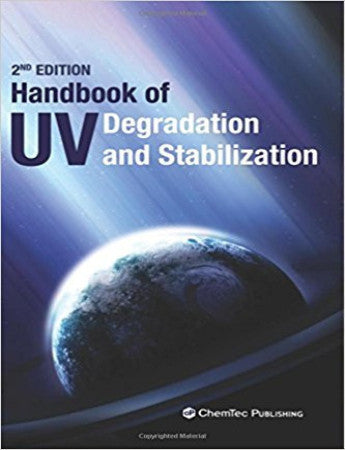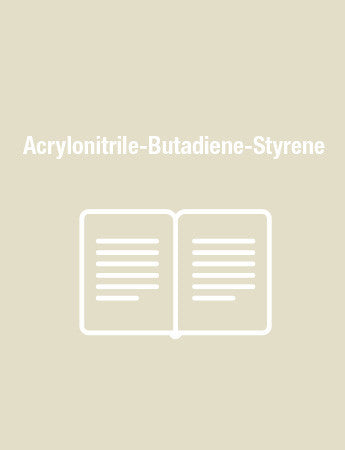Handbook of UV Degradation and Stabilization, 2nd Edition
This book, the first monograph fully devoted to UV degradation and stabilization ever published in the English language, has 12 chapters, each discussing different aspect of UV related phenomena occurring when polymeric materials are exposed to UV radiation.
In the introduction, the existing literature has been reviewed to find out how plants, animals, and humans protect themselves against UV radiation. This review permits evaluation of mechanisms of protection against UV used by living things and potential application of these mechanisms in the protection of natural and synthetic polymeric materials.
Photophysics, discussed in the second chapter, helps to build an understanding of physical phenomena occurring in materials when they are exposed to UV radiation. Potentially useful stabilization methods become obvious from the analysis of photophysics of the process.
These effects are combined with photochemical properties of stabilizers and their mechanisms of stabilization, which is the subject of Chapter 3.
Chapter 4 contains information on available UV stabilizers. It contains a set of data prepared according to a systematic outline as listed in the Table of Contents.
Stability of UV stabilizers, important for predicting the lifetime of their protection is discussed in Chapter 5. Different reasons of instability are pointed out in the evaluation.
Principles of stabilizer selection are given in Chapter 6. Ten areas of influence of stabilizer properties and expectations from the final products were selected for discussion in this chapter.
Chapters 7 and 8 give specific information on degradation and stabilization of different polymers & rubbers and final products manufactured from them, respectively. Over 50 polymers and rubbers are discussed in different sections of Chapter 7 and 38 groups of final products, which use the majority of UV stabilizers are discussed in Chapter 8. In addition, more focused information is provided in Chapter 9 for sunscreens. This is an example of new developments in technology. The subjects discussed in each individual case of polymer or group of products are given in Table of Contents.
Specific effects of UV stabilizers which may affect formulation because of interaction between UV stabilizers and other components of formulations are discussed in Chapter 10. Analytical methods, which are most frequently used in UV stabilization, are discussed in Chapter 11 to show their potential for further understanding of UV degradation and stabilization.
The book is concluded with the effect of UV stabilizers on the health and safety of workers involved in their processing and commercial use of the products (Chapter 12).
In the introduction, the existing literature has been reviewed to find out how plants, animals, and humans protect themselves against UV radiation. This review permits evaluation of mechanisms of protection against UV used by living things and potential application of these mechanisms in the protection of natural and synthetic polymeric materials.
Photophysics, discussed in the second chapter, helps to build an understanding of physical phenomena occurring in materials when they are exposed to UV radiation. Potentially useful stabilization methods become obvious from the analysis of photophysics of the process.
These effects are combined with photochemical properties of stabilizers and their mechanisms of stabilization, which is the subject of Chapter 3.
Chapter 4 contains information on available UV stabilizers. It contains a set of data prepared according to a systematic outline as listed in the Table of Contents.
Stability of UV stabilizers, important for predicting the lifetime of their protection is discussed in Chapter 5. Different reasons of instability are pointed out in the evaluation.
Principles of stabilizer selection are given in Chapter 6. Ten areas of influence of stabilizer properties and expectations from the final products were selected for discussion in this chapter.
Chapters 7 and 8 give specific information on degradation and stabilization of different polymers & rubbers and final products manufactured from them, respectively. Over 50 polymers and rubbers are discussed in different sections of Chapter 7 and 38 groups of final products, which use the majority of UV stabilizers are discussed in Chapter 8. In addition, more focused information is provided in Chapter 9 for sunscreens. This is an example of new developments in technology. The subjects discussed in each individual case of polymer or group of products are given in Table of Contents.
Specific effects of UV stabilizers which may affect formulation because of interaction between UV stabilizers and other components of formulations are discussed in Chapter 10. Analytical methods, which are most frequently used in UV stabilization, are discussed in Chapter 11 to show their potential for further understanding of UV degradation and stabilization.
The book is concluded with the effect of UV stabilizers on the health and safety of workers involved in their processing and commercial use of the products (Chapter 12).
1. Introduction
2. Photophysics and photochemistry
3. Mechanisms of UV stabilization
4. UV stabilizers (chemical composition, physical-chemical properties, UV absorption, forms, applications – polymers and final products, concentrations used)
5. Stability of UV stabilizers
6. Principles of stabilizer selection
7. UV degradation and stabilization of polymers and rubbers (description according to the following outline: mechanisms and results of degradation, mechanisms and results of stabilization, and data on activation wavelength (spectral sensitivity), products of degradation, typical results of photodegradation, most important stabilizers, concentration of stabilizers in formulation, and examples of lifetime of typical polymeric materials)
8. UV degradation and stabilization of industrial products (description according to the following outline: requirements, lifetime expectations, important changes and mechanisms, stabilization methods)
9 Focus on technology - Sunscreen
10 UV stabilizers and other components of formulation
11 Analytical methods in UV degradation and stabilization studies
12 UV stabilizers – health, safety, and environment
2. Photophysics and photochemistry
3. Mechanisms of UV stabilization
4. UV stabilizers (chemical composition, physical-chemical properties, UV absorption, forms, applications – polymers and final products, concentrations used)
5. Stability of UV stabilizers
6. Principles of stabilizer selection
7. UV degradation and stabilization of polymers and rubbers (description according to the following outline: mechanisms and results of degradation, mechanisms and results of stabilization, and data on activation wavelength (spectral sensitivity), products of degradation, typical results of photodegradation, most important stabilizers, concentration of stabilizers in formulation, and examples of lifetime of typical polymeric materials)
8. UV degradation and stabilization of industrial products (description according to the following outline: requirements, lifetime expectations, important changes and mechanisms, stabilization methods)
9 Focus on technology - Sunscreen
10 UV stabilizers and other components of formulation
11 Analytical methods in UV degradation and stabilization studies
12 UV stabilizers – health, safety, and environment
George Wypych has a Ph. D. in chemical engineering. His professional expertise includes both university teaching (full professor) and research & development. He has published 16 books: PVC Plastisols, (University Press); Polyvinylchloride Degradation, (Elsevier); Polyvinylchloride Stabilization, (Elsevier); Polymer Modified Textile Materials, (Wiley & Sons); Handbook of Material Weathering, 1st, 2nd, 3rd, and 4th Editions, (ChemTec Publishing); Handbook of Fillers, 1st and 2nd Editions, (ChemTec Publishing); Recycling of PVC, (ChemTec Publishing); Weathering of Plastics. Testing to Mirror Real Life Performance, (Plastics Design Library), Handbook of Solvents, Handbook of Plasticizers, Handbook of Antistatics, Handbook of Antiblocking, Release, and Slip Additives, PVC Degradation & Stabilization, The PVC Formulary, Handbook of Biodegradation, Biodeterioration , and Biostabilization, Handbook of UV Degradation and Stabilization (all by ChemTec Publishing), 47 scientific papers, and he has obtained 16 patents. He specializes in polymer additives, polymer processing and formulation, material durability and the development of sealants and coatings. He is included in the Dictionary of International Biography, Who's Who in Plastics and Polymers, Who's Who in Engineering, and was selected International Man of the Year 1996-1997 in recognition for his services to education.




